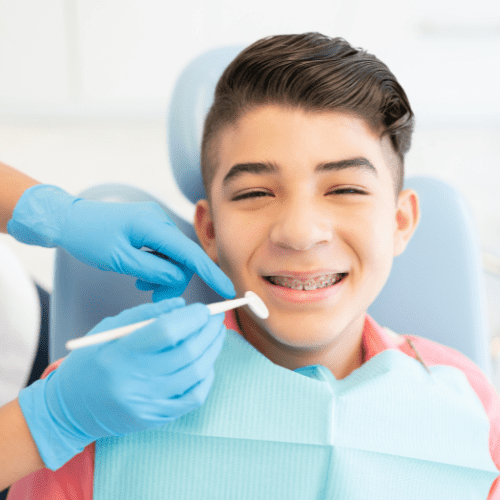1. Fillings and Restorations
1. Fillings and Restorations

Children’s teeth will require treatment once decay sets in. The decayed portion of the teeth is meticulously removed from the tooth structure which then requires to be restored using filling materials.

Various types of filling materials have been invented and used for ages. The popular silver amalgam fillings are now getting out- favored by newer materials with better properties. In pediatric dentistry, the commonly used materials are glass ionomers, resin-modified glass ionomers, composite resins like white fillings or invisible fillings, and sometimes multicolored fillings for novelty effects.

Filling and restorative processes are generally painless but deeper and extensively decayed teeth treatment might just get a little discomforting requiring local anesthesia. With the advent of very thin, almost hairlike needles meant for local anesthesia, even the numbing process is getting increasingly acceptable for young kids.

Sometimes deeper cavities might require certain medicament layering before final filling to protect and soothe the underlying nerves and take care not to irritate them.

Treatment procedures are done in our center in a way not to tire the patient and retains their cooperation. So spaced-out treatment sittings are generally preferred.

Dr. Bhavsar is also one of the first professionals to use a chemo-mechanical cavity removal system called Carisolv imported from Sweden. With this system, only the decayed portion of the tooth is dissolved with chemicals thereby reducing the need of using the dreaded drill. And after this process, the dissolved portions are removed using special instruments which makes the entire procedure quite a pain-free.
3. Crowns
Crowns are meant for complete coverage of extensively damaged teeth which are not possible to restore with fillings alone. Traditional stainless steel (SS) crowns and the newer tooth colored natural looking Zirconia crowns are used for primary as well as young permanent teeth. Such preformed crowns offer full coverage over the tooth structure leaving no chance for secondary decay formation. Various crown sizes are available for each and every teeth, thus correct crown selection is done by Dr. Bhavsar which are then trimmed, grinded selectively and fitted over the teeth in their proper positions, all in one sitting. Same is the case for anterior teeth, wherein strip crowns and zirconia crowns are used. These crowns are relatively pliable, don’t fracture and maintain a snug fit during entire growth and development and movement of the jaws. The crowns are indicated especially after root canal treatment, over hypoplastic teeth and over badly broken down eroded teeth. These crowns also resist erosion and enhance the vertical height of the teeth.
4. Space Management And Space Maintainers
The milk teeth are ideally designed to fall off at regular intervals from between 6 to 12 years of age, so that new teeth can erupt turn by turn sequentially into their proper positions. But if the milk teeth are lost or removed prematurely the new teeth are only going to erupt at their destined time. Therefore space has to be maintained to prevent problems of irregularities and abnormal eruptions of permanent teeth from occurring. This can be done by using appliances known as space maintainers. It is always sensible to keep teeth in normal positions with a space maintainer which is comfortable, easy, and far less expensive than a major orthodontic treatment to move the teeth back in place.
What is a space maintainer?
A space maintainer “holds” the space until a new tooth grows in and prevents the teeth from moving toward empty spaces in the mouth.
6. Mouthguards
What is a mouthguard ?
When would I need a mouthguard?
When would I need a mouthguard?

7. Early Orthodontics And Minor Tooth Movement
The primary aim of preventive and interceptive orthodontic treatment in the mixed dentition is to correct initial dental and orofacial irregularities creeping insidiously and to eliminate interferences toward the development of normal occlusion. Certain appliances and correctors using wires, elastics, and springs may be needed to correct and redirect the positions of newly erupting teeth and growing jaws. Get a thorough examination done by a pediatric dentist to diagnose such irregularities, for example, anterior crossbites wherein upper anterior teeth are placed on the inside of the lower anterior teeth when the mouth is closed or newly erupting teeth arriving on the outside or the inside the arch row of teeth etc.
7. Early Orthodontics And Minor Tooth Movement

The primary aim of preventive and interceptive orthodontic treatment in the mixed dentition is to correct initial dental and orofacial irregularities creeping insidiously and to eliminate interferences toward the development of normal occlusion. Certain appliances and correctors using wires, elastics, and springs may be needed to correct and redirect the positions of newly erupting teeth and growing jaws. Get a thorough examination done by a pediatric dentist to diagnose such irregularities, for example, anterior crossbites wherein upper anterior teeth are placed on the inside of the lower anterior teeth when the mouth is closed or newly erupting teeth arriving on the outside or the inside the arch row of teeth etc.
8. Cosmetic Dentistry
This aspect involves :

8. Cosmetic Dentistry
This aspect involves :


9. Dental Trauma Management And Emergencies
Trauma from falls at home, on the playground, or during athletic events is a frequent cause of injury to the teeth and soft tissues of the mouth. Often the extent of injury or its effects will not be obvious to even the most observant parent. The length of time between the accident and the treatment is often the most important factor in determining the prognosis for a tooth that has been injured. Early observation and treatment of injuries can reduce the danger of more serious problems occurring. A primary tooth that is fractured or discolored may become infected. The infection will in all probability seriously damage the succeeding permanent tooth.
The sooner the tooth is replaced the better the chance of success. If you have not managed to do it yourself, the dentist will put the tooth back. They may use a dental splint to fasten the tooth against the teeth on either side. In most cases this is successful and once the splint is removed, the tooth is stable. However, you will certainly need more treatment in the future.
9. Dental Trauma Management And Emergencies

Trauma from falls at home, on the playground, or during athletic events is a frequent cause of injury to the teeth and soft tissues of the mouth. Often the extent of injury or its effects will not be obvious to even the most observant parent. The length of time between the accident and the treatment is often the most important factor in determining the prognosis for a tooth that has been injured. Early observation and treatment of injuries can reduce the danger of more serious problems occurring. A primary tooth that is fractured or discolored may become infected. The infection will in all probability seriously damage the succeeding permanent tooth.
The sooner the tooth is replaced the better the chance of success. If you have not managed to do it yourself, the dentist will put the tooth back. They may use a dental splint to fasten the tooth against the teeth on either side. In most cases this is successful and once the splint is removed, the tooth is stable. However, you will certainly need more treatment in the future.
10. Orthodontic Treatment

10. Orthodontic Treatment

11. Other Services $ Support
11. Other Services $ Support






